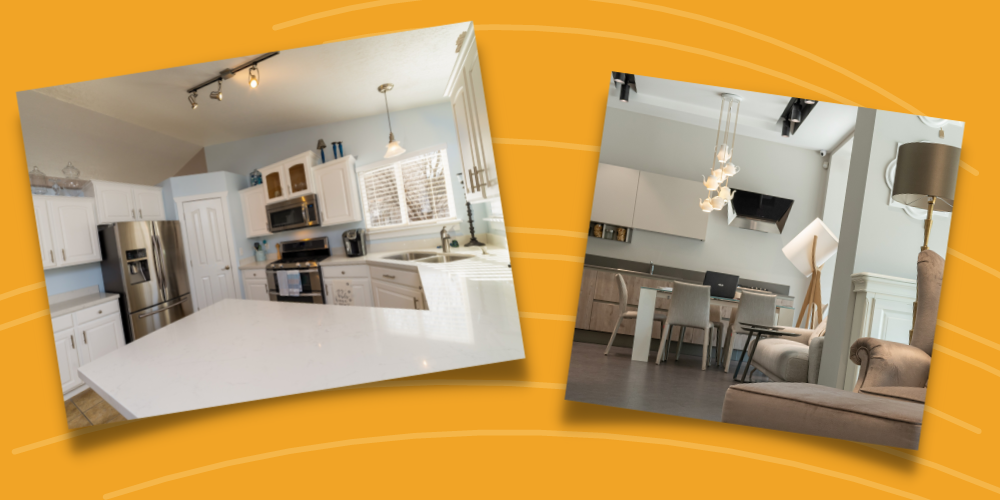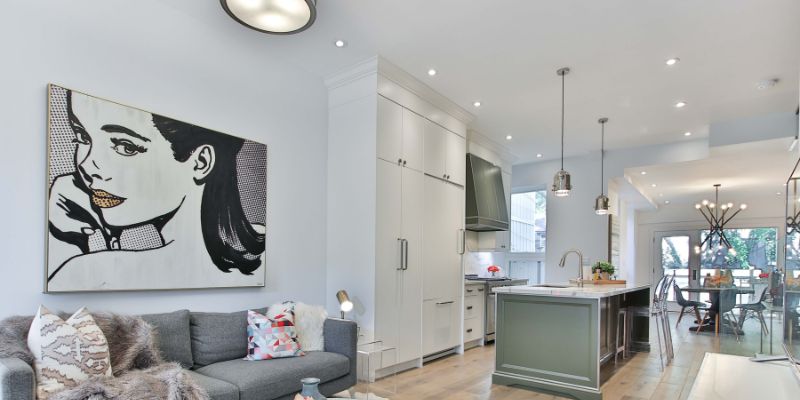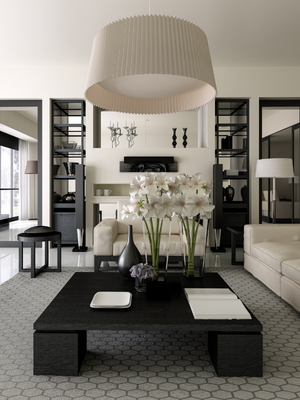When we think about updating our homes, we often focus on paint colors, furnishings, fixtures, and décor. We don’t always pay much attention to types of lighting we choose. But when it comes down to it, one of the most underappreciated design elements in our homes is light. Not only is it an essential part of interior design, lighting is also a powerful tool. One of the most important lighting techniques is layering lighting, which is used to add dimension, help define spaces, and can also change the mood of any room.
So, what’s one of the best—and easiest— ways to use layering lighting to achieve your desired look and atmosphere in every room? Add new light layers by replacing your old can lights with updated fixtures using our recessed light conversion kit. In a single weekend, you can completely transform any space in your home by simply layering lighting. Read on to learn more about these professional lighting techniques you can start implementing in your very own home!
What are Light Layers?
One of the most important lighting techniques used by designers is layering lighting. It may sound a little fancy, but don’t worry, you don’t have to be a professional to understand and use light layers in your home. Simply put, layering lighting is a method of using different types of lighting at the same time and within a single space to give it functionality and evoke a certain feeling. Once you know the basics, you can use these lighting techniques to guide you on your next DIY lighting project. Now, let’s learn a bit more about lighting in layers!

Want to learn to light your home like a pro? Learn how The Can Converter can help you create multiple light layers that add depth and dimension to your any room.
Why Do I Need Light Layers?
Have you ever noticed how some rooms just feel good while other spaces make you feel uncomfortable? Chances are, it’s because of the lighting. And more often than not, it’s a lack of light layers. Poorly lit rooms can cause eye strain, affect our energy levels, and even make you feel anxious. Without layering lighting, your spaces may end up feeling flat and dull. The answer to this is lighting in layers.
How Does Layer Lighting Design Work?
Imagine a room with only a single source of lighting. Does it feel inviting and cozy? Probably not. But layering lighting can help keep areas in your home from feeling gloomy and uninspired. When you convert recessed light to pendant, for example, these new light layers instantly add more depth and visual interest to spaces like kitchens and living rooms. Instead of feeling one-dimensional, layering lighting makes rooms feel more dynamic.
The key to creating a visual balance of light layers revolves around using three main types of lighting: ambient lights, accent lights, and task lights. Together, these act as a foundation for every interior setting. Let’s take a look at why each one is important, how they work together to enhance the beauty and function of any room, and how The Can Converter can help you incorporate the technique of layering lighting in your home.
 Ambient Lights
Ambient Lights
When planning a well-lit, balanced layer lighting design, you’ll want to start with ambient lights. This is your room’s central source of light. The goal is to make the room bright enough for basic use and safe navigation. Used alone, ambient lights might seem a bit boring, but they are critical in providing a foundation for the other two light layers.
Typically soft and diffused, ambient lights are used to illuminate the entire room. Any type of fixture, from pendants to flush mount lights, a chandelier or even a ceiling fan light, can be used as ambient lights. Layering lighting always begins with determining what you need for your ambient lights first before moving on to identifying your needs for task and accent lighting. Once you’re done with this step, it’s time to add some additional depth with two more types of lighting.
Task Lights
Next up on our list of essential light layers to incorporate are task lights. Encompassing everything from under cabinet LEDs to pendants, these are all about function. Using placement and brightness to reinforce your other light layers, they create dimension as well as help you perform a distinct job. Have a room illuminated only by pot lights? Put these lighting techniques to work by using a can converter kit to add much-needed task lights with pendants hung at just the right height over a counter, vanity, table, or workspace. As a supplement to ambient lights, task lights should also do away with any distracting shadows and be bright enough to prevent eye strain without creating glare.

From kitchen islands to craft tables, task lighting is an important component of lighting in layers.
Accent Lights
 Accent lights are the final touch and help give your spaces a polished look that the others alone can’t provide. Accent lights are used to highlight specific things like artwork, furnishings, or architectural details. As the last of the light layers, they focus on adding drama, style, contrast, and depth to your lighting design. If you’ve ever walked into a room and felt like that certain something was missing, it very well may have been accent lights.
Accent lights are the final touch and help give your spaces a polished look that the others alone can’t provide. Accent lights are used to highlight specific things like artwork, furnishings, or architectural details. As the last of the light layers, they focus on adding drama, style, contrast, and depth to your lighting design. If you’ve ever walked into a room and felt like that certain something was missing, it very well may have been accent lights.
You might think of them as less important or as simply decorative afterthoughts, but accent lights serve an important role in achieving that delicate balance of light. In a room with plenty of ambient lights but no accent lighting, for example, you might convert recessed light to track light to achieve a more pleasing look. These types of lighting fixtures offer the benefit of adjustable heads that let you angle and redirect light into other areas to create a real wow factor and a richer, multi-dimensional environment. Lighting in layers can be used to this effect for wall washing, bookcase displays, and focal points of all types.
Creating the Perfect Layer Lighting Design
As you can see, the perfect illumination for any room is all about layering lighting. And with The Can Converter, it’s both easy and affordable to add different light layers. So why not light up your home like a pro? Use these lighting techniques to create a mix of practical and aesthetic lighting that completely transforms your space. Lighting in layers can also be used to give the impression that a room is larger than it really is. And if you add dimmers to your new fixtures, you’ll have even more control over customizing your layer lighting design. The hardest part of all will simply be choosing the types of lighting styles you want to complement your décor.
Ready to start layering lighting? Gather inspiration from our Before & After gallery, where homeowners have shared photos of types of lighting projects. You can also find loads of helpful ideas and tips in our home lighting design guide. And when your lighting transformation is complete, we’d love to see photos or your project. Be sure to enter them into our Project of the Month Contest for a chance to win $50!


 Ambient Lights
Ambient Lights